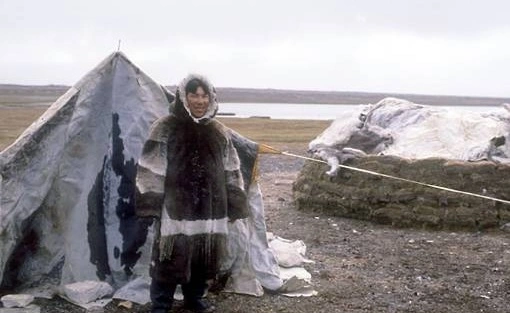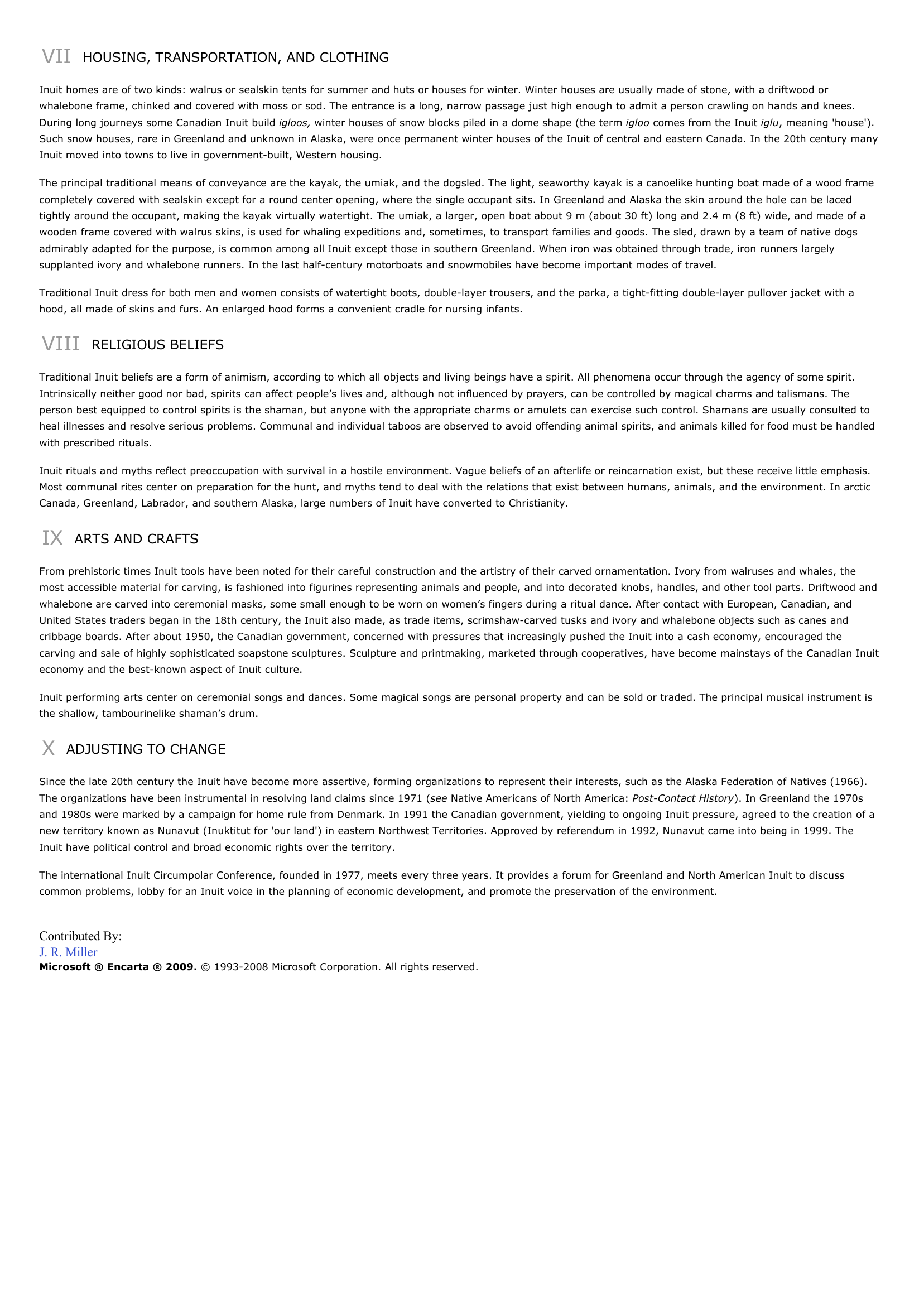Inuit.
Publié le 03/05/2013

Extrait du document


«
VII HOUSING, TRANSPORTATION, AND CLOTHING
Inuit homes are of two kinds: walrus or sealskin tents for summer and huts or houses for winter.
Winter houses are usually made of stone, with a driftwood orwhalebone frame, chinked and covered with moss or sod.
The entrance is a long, narrow passage just high enough to admit a person crawling on hands and knees.During long journeys some Canadian Inuit build igloos, winter houses of snow blocks piled in a dome shape (the term igloo comes from the Inuit iglu, meaning 'house'). Such snow houses, rare in Greenland and unknown in Alaska, were once permanent winter houses of the Inuit of central and eastern Canada.
In the 20th century manyInuit moved into towns to live in government-built, Western housing.
The principal traditional means of conveyance are the kayak, the umiak, and the dogsled.
The light, seaworthy kayak is a canoelike hunting boat made of a wood framecompletely covered with sealskin except for a round center opening, where the single occupant sits.
In Greenland and Alaska the skin around the hole can be lacedtightly around the occupant, making the kayak virtually watertight.
The umiak, a larger, open boat about 9 m (about 30 ft) long and 2.4 m (8 ft) wide, and made of awooden frame covered with walrus skins, is used for whaling expeditions and, sometimes, to transport families and goods.
The sled, drawn by a team of native dogsadmirably adapted for the purpose, is common among all Inuit except those in southern Greenland.
When iron was obtained through trade, iron runners largelysupplanted ivory and whalebone runners.
In the last half-century motorboats and snowmobiles have become important modes of travel.
Traditional Inuit dress for both men and women consists of watertight boots, double-layer trousers, and the parka, a tight-fitting double-layer pullover jacket with ahood, all made of skins and furs.
An enlarged hood forms a convenient cradle for nursing infants.
VIII RELIGIOUS BELIEFS
Traditional Inuit beliefs are a form of animism, according to which all objects and living beings have a spirit.
All phenomena occur through the agency of some spirit.Intrinsically neither good nor bad, spirits can affect people’s lives and, although not influenced by prayers, can be controlled by magical charms and talismans.
Theperson best equipped to control spirits is the shaman, but anyone with the appropriate charms or amulets can exercise such control.
Shamans are usually consulted toheal illnesses and resolve serious problems.
Communal and individual taboos are observed to avoid offending animal spirits, and animals killed for food must be handledwith prescribed rituals.
Inuit rituals and myths reflect preoccupation with survival in a hostile environment.
Vague beliefs of an afterlife or reincarnation exist, but these receive little emphasis.Most communal rites center on preparation for the hunt, and myths tend to deal with the relations that exist between humans, animals, and the environment.
In arcticCanada, Greenland, Labrador, and southern Alaska, large numbers of Inuit have converted to Christianity.
IX ARTS AND CRAFTS
From prehistoric times Inuit tools have been noted for their careful construction and the artistry of their carved ornamentation.
Ivory from walruses and whales, themost accessible material for carving, is fashioned into figurines representing animals and people, and into decorated knobs, handles, and other tool parts.
Driftwood andwhalebone are carved into ceremonial masks, some small enough to be worn on women’s fingers during a ritual dance.
After contact with European, Canadian, andUnited States traders began in the 18th century, the Inuit also made, as trade items, scrimshaw-carved tusks and ivory and whalebone objects such as canes andcribbage boards.
After about 1950, the Canadian government, concerned with pressures that increasingly pushed the Inuit into a cash economy, encouraged thecarving and sale of highly sophisticated soapstone sculptures.
Sculpture and printmaking, marketed through cooperatives, have become mainstays of the Canadian Inuiteconomy and the best-known aspect of Inuit culture.
Inuit performing arts center on ceremonial songs and dances.
Some magical songs are personal property and can be sold or traded.
The principal musical instrument isthe shallow, tambourinelike shaman’s drum.
X ADJUSTING TO CHANGE
Since the late 20th century the Inuit have become more assertive, forming organizations to represent their interests, such as the Alaska Federation of Natives (1966).The organizations have been instrumental in resolving land claims since 1971 ( see Native Americans of North America: Post-Contact History ).
In Greenland the 1970s and 1980s were marked by a campaign for home rule from Denmark.
In 1991 the Canadian government, yielding to ongoing Inuit pressure, agreed to the creation of anew territory known as Nunavut (Inuktitut for 'our land') in eastern Northwest Territories.
Approved by referendum in 1992, Nunavut came into being in 1999.
TheInuit have political control and broad economic rights over the territory.
The international Inuit Circumpolar Conference, founded in 1977, meets every three years.
It provides a forum for Greenland and North American Inuit to discusscommon problems, lobby for an Inuit voice in the planning of economic development, and promote the preservation of the environment.
Contributed By:J.
R.
MillerMicrosoft ® Encarta ® 2009. © 1993-2008 Microsoft Corporation.
All rights reserved..
»
↓↓↓ APERÇU DU DOCUMENT ↓↓↓
Liens utiles
- Victor, Banquise (extrait) Publié en 1939, Banquise est le premier récit livré par Paul-Émile Victor de ses deux hivernages chez les Inuit d'Angmassalik -- les Esquimaux d'Ammassadik pour l'auteur.
- Familles amérindiennes Familles et emprunts Famille eskimo-aléoute l'inuktitut anorak, iglou, Inuit, kayak, etc.












